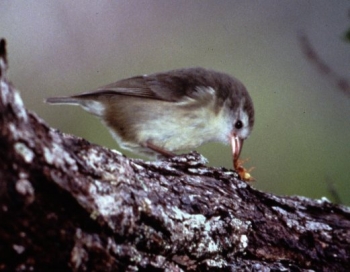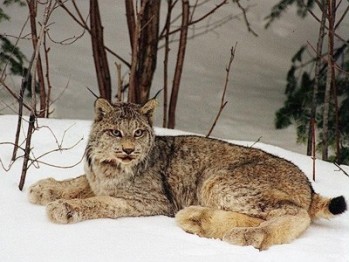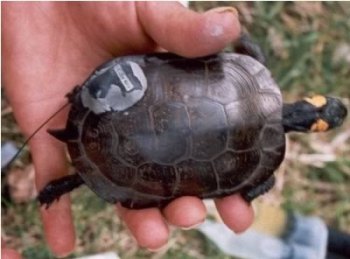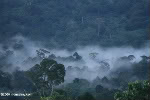A new report, America’s Hottest Species, highlights a variety of American wildlife that are currently threatened by climate change from a small bird to a coral reef to the world’s largest marine turtle.
“Global warming is like a bulldozer shoving species, already on the brink of extinction, perilously closer to the edge of existence,” said Leda Huta, executive director of the Endangered Species Coalition which produced the report. “Polar bears, lynx, salmon, coral and many other endangered species are already feeling the heat.”
The report includes:
 A juvenile’Akikiki. Photo by: Jack Jeffrey. |
1) the Kaua’i Creeper, or ‘Akikiki, which is endemic to the Hawaiian island of Kaua’i. With warming temperatures conservationists are concerned that its habitat will be overrun by non-native mosquitoes carrying Avian malaria. Because mosquitoes were only introduced to the Hawaiian Islands in the 19th Centuries, these birds have no natural resistance to their diseases.
2) Elkhorn coral was once dominant in Floridian and Caribbean waters, but this species has been decimated (dropping by 90 percent) due to disease and warming waters which cause coral bleaching. Higher temperature cause vital algae to abandon the coral, leaving them open to disease and sometimes mortality. Coral reefs are one of the world’s most threatened organisms due to climate change.
3) Bull trout require cold clean water and have vanished from much of their habitat due to human impacts on their river systems. Now climate change threatens the bull trout with warmer waters, warmer air, and a decrease in winter precipitation that provides that cold water necessary for the trout.
4) The Canadian lynx requires cold snowy winters in order to compete with bigger predators for their primary food, snowshoe hares. Large feet covered with fur have given the Canadian lynx an advantage in such habitats, but global warming may push this species further north and its migration may run into trouble due to increased isolation.
 The Canadian lynx. Photo by: US government. |
5) Pacific salmon have been heavily impacted by human activities, such as dams and pollution, which have hurt the people and other species dependent on the fish as a food source. Coldwater fish, Pacific salmon—comprising seven species—cannot survive in waters above 72 degrees Fahrenheit and rising summer temperatures are further diminishing already devastated populations.
6) The world’s largest and most ancient marine turtle, the leatherback, has seen its population plummet over the past few decades due to becoming prey to bycatch, destruction of important nesting areas, and pollution. But climate change poses a new problem. The sex of the leatherback’s offspring is temperature-dependent, meaning that warmer temperatures in the nests create females while colder temperatures, males. With warming temperatures, researchers are concerned that male leatherbacks will simply vanish in favor of females and the species soon after.
7) Even America’s largest bear, the grizzly bear, is having difficulty in a warmer world. An important food source for grizzlies in some areas–the Whitebark pines’ seeds—are declining due to increased disease from warmer temperatures. In addition, conservationists fear that warmer temperatures will bring grizzlies into increased contact with humans, which is never good for bears.
8) The bog turtle, the smallest in the United States, is threatened by erratic weather patterns on its fragile habitat. Flooding or drought in bogs will in turn kill the tiny turtles. Fractured habitats by roads and developments will also make it difficult for this rare species to migrate to other suitable bogs.
 Conservationist attaching radio tracking device to bog turtle. Photo by: Teresa Amitrone. |
9) The western prairie fringed orchid is a lovely flower which has lost much of its prairie habitat due to land conversion for agriculture and livestock. Climate change-caused drought will lessen the habitat available for the western prairie fringed orchid even more and make it increasingly difficult for its pollinator, the hawkmoth, to reach it.
10) Flatlands salamanders are born in ponds and spend their lives in the Longlife Pine Flatwoods in the southern United States, however both of these ecosystems have been impacted by human developments. Increased drought due to climate change could dry up important ponds for the Flatlands salamanders, while rising sea levels would literally drown vital habitat.
Related articles
Zoos call for deeper emission cuts to save life on Earth
(11/30/2009) To save species around the world zoos say deeper emission cuts are needed than governments are currently proposing. Over 200 zoos worldwide have signed a petition calling on governments to set the target of atmospheric carbon below 350 parts per million (ppm) far lower than most government targets.
Declaration calls for more wilderness protected areas to combat global warming

(11/11/2009) Meeting this week in Merida, Mexico, the 9th World Wilderness Congress (WILD9) has released a declaration that calls for increasing wilderness protections in an effort to mitigate climate change. The declaration, which is signed by a number of influential organizations, argues that wilderness areas—both terrestrial and marine—act as carbon sinks, while preserving biodiversity and vital ecosystem services.
Global warming threatens desert life
(11/09/2009) There have been numerous studies showing how climate change is impacting a variety of environments—from the Arctic to coral reefs to alpine—but how could a warmer world damage deserts, already the world’s warmest and driest environments?
Freshwater species worse off than land or marine
(10/15/2009) Scientists have announced that freshwater species are likely the most threatened on earth. Extinction rates for freshwater inhabitants are currently four to six times the rates for terrestrial and marine species. Yet, these figures have not lead to action on the ground.
Photos: hundreds of new species discovered in Himalayan region, threatened by climate change

(08/10/2009) Scientists from a variety of organizations have found over 350 new species in the Eastern Himalayas, including a flying frog, the world’s smallest deer, and a gecko which has walked the earth for 100-million-years, according to a new report by the World Wildlife Fund (WWF). The report, entitled Where World’s Collide, warns that these rare biological treasures, as well as numerous other species, are threatened in the Eastern Himalayas by climate change.
New report predicts dire consequences for every U.S. region from global warming

(06/17/2009) Government officials and scientists released a 196 page report detailing the impact of global warming on the U.S. yesterday. The study, commissioned in 2007 during the Bush Administration, found that every region of the U.S. faces large-scale consequences due to climate change, including higher temperatures, increased droughts, heavier rainfall, more severe weather, water shortages, rising sea levels, ecosystem stresses, loss of biodiversity, and economic impacts.
Bird migrations lengthen due to global warming, threatening species

(04/15/2009) Global warming is likely to increase the length of bird migrations, some of which already extend thousands of miles. The increased distance could imperil certain species, as it would require more energy reserves than may be available. The new study, published in the Journal of Biogeography, studied the migration patterns of European Sylvia warblers from Africa to breeding grounds in Europe every spring. They discovered that climate change would likely push the breeding ranges of birds north, causing migrations to lengthen, in some cases by a total of 250 miles.
Climate change could devastate lizards in the tropics

(03/04/2009) With help from data collected thirty years ago, scientists have discovered that tropical lizards may be particularly sensitive to a warming world. Researchers found that lizards in the tropics are more sensitive to higher temperatures than their relatives in cooler, yet more variable climates. “The least heat-tolerant lizards in the world are found at the lowest latitudes, in the tropical forests. I find that amazing,” said Raymond Huey, lead author of a paper appearing in the March 4 Proceedings of the Royal Society B.
Global warming may doom emperor penguins to extinction
(01/27/2009) Disappearing sea ice around Antarctica may put emperor penguins at risk of extinction within the next century, warn scientists writing in this week’s Proceedings of the National Academy of Sciences.
What is the greatest threat to rainforests: habitat destruction or climate change?

(01/13/2009) A symposium from the Smithsonian Institution meant to debate the level of threat by deforestation posed to the tropics shifted topic slightly near its end as scientists began to discus which was the most significant threat for rainforests and the species that inhabit them: habitat destruction or climate change?














